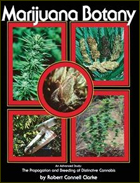
by Robert Connell Clarke
Harvesting, Drying and Curing
Cannabis is cultivated for the harvest of several different commercial products. Pulp, fiber, seed, buds, and resin are produced from various parts of the Cannabis plant. The methods of harvesting, drying, curing, and storing various plant parts are determined by the intended use of the plant. Pulp is made from the leaves of juvenile plants and from waste products of fiber and bud production. Fibers are produced from the stems of the Cannabis plant. The floral clusters are responsible for the production of seeds, buds, and aromatic resins.
If plants are to be used solely as a pulp source for paper production, they may be harvested at any point in the life cycle when they are large enough to produce a reasonable yield of leaves and small stems. The leaves and small stems are stripped from the larger stalks, and after drying they are bailed and stored or made directly into paper pulp. Cannabis contains approximately 67% cellulose and 16% hemicellulose; this makes a fine resilient paper. In Italy, the finest Bibles are printed on hemp paper.
Fiber or hemp Cannabis is usually grown in large, crowded fields. Crowding of seedlings results in tall, thin plants with few limbs and long, straight fibers. The total field is harvested when the fiber content reaches the correct level but before the fibers begin to lignify or harden. The cut stalks are stripped of leaves and bundled to dry. Fibers are extracted by natural or chemical retting, Retting is the breaking down of the outside skin layer and tissues that join the fibers into bundles, so that the individual fibers are freed. Natural retting is accomplished by soaking the stalks in water and laying them out on the ground, where they are attacked by decay organisms such as fungi and bacteria. Dew may also wet the stalks, and they are turned frequently to evenly wet them and avoid excessive decay. Continued soaking, attack by organisms, and pounding of the stalks results in the liberation of individual fibers from their vascular bundles. Natural retting takes from one week to a month. The fibers are thoroughly dried, wrapped in bundles and stored in a cool, dry area. The yield of fiber is approximately 25% of the weight of the dried stalks.
Seeds are harvested by cutting fields of seeded pistillate plants and removing the seeds either by hand or machine. Cannabis seeds usually fall easily from the floral clusters when mature. The remainder of the plant may be used as pulp material or low-grade marijuana. The Indian tradition of preparing ganja is by walking on it and rolling it between the palms to remove excess seeds and leaves. Seeds are allowed to dry completely and all vegetable debris is removed before storage. This prevents spoilage caused by molds and other fungi. Seeds to be used for oil production may be stored in bags, boxes, or jars, and not exposed to excess humidity (causing them to germinate) or excessive aridity (causing them to dry out and crack). Seeds preserved for future germination are thoroughly air dried in paper envelopes or cloth sacks and stored in airtight containers in a cool, dark, dry place. Freezing may also dry out seeds and cause them to crack. If seeds are carefully stored, they remain viable for a number of years. As a batch of seeds ages, fewer and fewer of them will germinate, but even after 5 to 6 years a small percentage of the seeds usually still germinate. Old batches of seeds also tend to germinate slowly (up to 5 weeks). This means that a batch of seeds for cultivation might be stored for a longer time if the initial sample is large enough to provide sufficient seeds for another generation. If a strain is to be preserved, it is necessary to grow and reproduce it every three years, so that enough viable seeds are always available.

